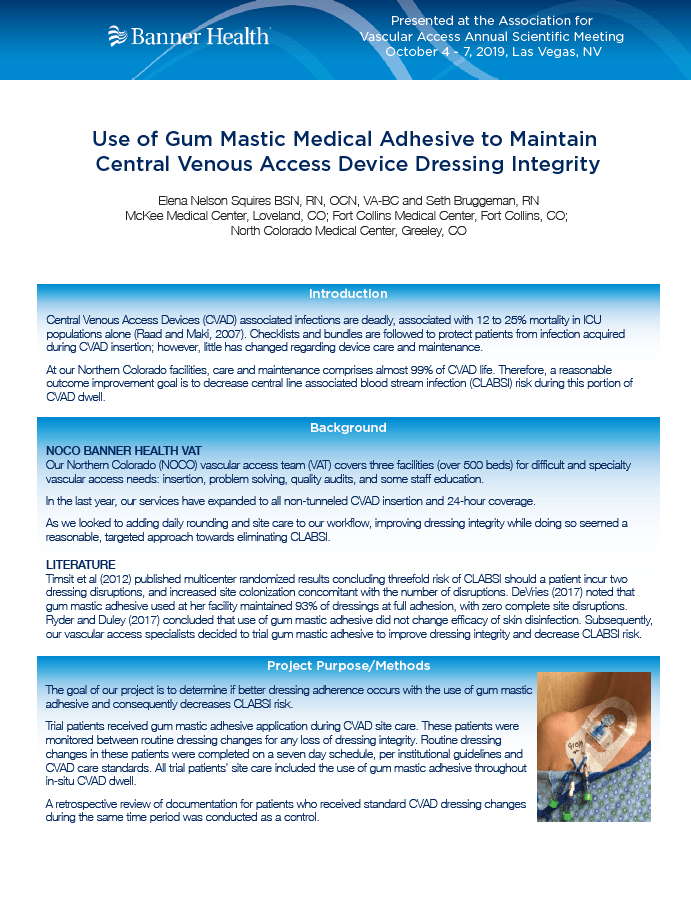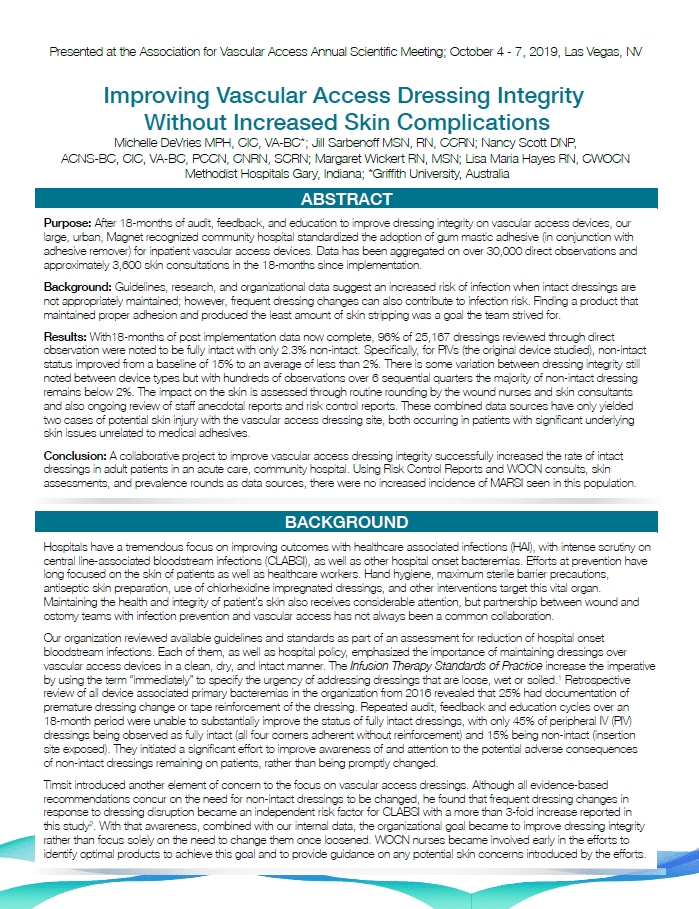
Vascular Access Dressing Adherence and Hospital-acquired Infections
Central venous access device (CVAD) related infections have a 12‐25% mortality in ICU populations. [1] Due to dressing disruption, central line‐associated bloodstream infection (CLABSI) may occur. The US Centers for Disease Control and Prevention (CDC) and the Infusion Nurses Society (INS) agree that vascular access device (VAD) dressing integrity plays a prominent role in preventing hospital‐acquired infections. [2,3]
Quality Improvement Evidence on Gum Mastic Adhesive and Dressing Integrity
Below is some of the latest quality improvement evidence on central and peripheral VAD dressing integrity, presented at the Association for Vascular Access (AVA) Annual Scientific Meeting in October of 2019.
Use of Gum Mastic Medical Adhesive to Maintain Central Venous Access Device Dressing Integrity
[5] A study took place to determine if gum mastic adhesive promoted better CVAD dressing adherence and decreased CLABSI risk. The trial patients’ dressings were applied using gum mastic adhesive during CVAD site care. Control patients received standard CVAD dressings. Seven of 20 control patients (35%) had early dressing disruption compared to 0 disruptions in the 33 patients (0%) with gum mastic adhesive. No patients in either group developed CLABSI.
A cost analysis found that using an extra CVAD dressing kit for the 7 patients with early dressing disruptions costs twice as much as supplying gum mastic adhesive for all 20 control patients ($63 versus $27). When nursing time is considered, cost estimates increase. A CVAD dressing change requires at least 15 minutes, at a labor cost of $13.82 (Registered Nurse hourly labor cost is $55.27)4. Seven extra CVAD dressing changes cost $96.75 in labor compared to $18.40 for gum mastic adhesive. Application of gum mastic adhesive only requires an additional minute for each CVAD dressing change, costing
$0.92.
This study demonstrates that gum mastic adhesive improved CVAD dressing integrity and may lower CLABSI risk. Additionally, fewer dressing disruptions reduced facility expenditures and improves clinician efficiency.

Complete Form to Download Poster
Improving Vascular Access Dressing Integrity Without Increased Skin Complications
[6] After an 18-month audit examining dressing integrity on vascular access devices, the use of gum mastic adhesive in combination with Detachol® Adhesive Remover was standardized for all VAD dressings. After another 18 months, this standardization resulted in 96% of 25,167 dressings being fully intact with the use of gum mastic adhesive with only 2.3% non-intact. For peripheral IVs (PIVs) specifically, non-intact status improved from 15% to less than 2%. Only 2 potential skin injuries at the VAD dressing site occurred, both in patients with skin issues unrelated to the adhesive. The use of gum mastic adhesive helped maintain dressing integrity and the use of Detachol® Adhesive remover helped to remove dressings safely. Proper adhesion and less skin stripping strongly aided in preventing CLASBI.
With the addition of gum mastic adhesive, VAD dressing integrity was improved with an increased rate of intact dressings while no increased MARSI incidents were seen during the audit.

Complete Form to Download Poster

For more information about Mastisol® Liquid Adhesive, Detachol® Adhesive Remover, or information on Vascular Access Dressing Adherence Point Prevalence Assessments, please contact your sales consultant or Eloquest Healthcare®, Inc., call 1-877-433-7626 or visit www.eloquesthealthcare.com.
According to evidence of advanced care of VAD dressing sites, the prevention of CLABSI and MARSI development is supported through improved dressing integrity. [2,3] Eloquest Healthcare’s products support strategies that prevent hospital acquired infections and provide better outcomes, higher quality and lower healthcare costs.
References
1. Raad, I., Hend, H., and Maki, D. (2007). Intravascular catheter-related infections: advances in diagnosis, prevention, and management. The Lancet: Infectious Diseases, 7(10), p. 645-657.
2. O’Grady NP, Alexander M, Burns LA, et al. Guidelines for the prevention of intravascular catheter-related infections, 2011.
https://cdc.gov/hicpac/pdf/guidelines/bsiguidelines2011.pdf. Accessed January 8, 2019.
3. Vascular Access Device Management. In: Infusion Therapy Standards of Practice. J Infus Nurs. 2016; 39:S68-S94.
4. U.S. Department of Labor: Bureau of Labor Statistics. (2018).Employer Costs for Employee Compensation-June 2018. [Data File]. Retrieved from
https://www.bls.gov/news.release/pdf/ecec.pdf
5. Nelson Squires E, Bruggeman S. Use of Gum Mastic Medical Adhesive to Maintain Central Venous Access Device Dressing Integrity. Poster presented at: 2019 Association for Vascular Access Meeting; October 2019; Las Vegas, NV.
6. DeVries M, Sarbenoff J, Scott N, Wickert M, Hayes L. Improving Vascular Access Dressing Integrity Without Increased Skin Complications. Poster presented at: 2019 Association for Vascular Access Meeting; October 2019; Las Vegas, NV.







